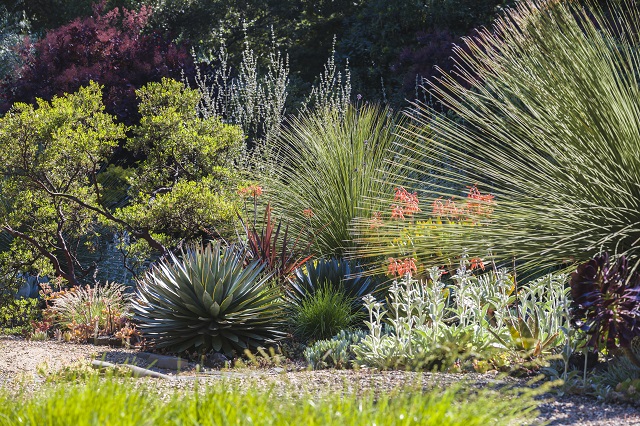
Whether you’re worried about the impact of climate change on future generations or you simply want to save on your monthly utility bill, a water-friendly yard is a great way to reduce your consumption of one of the planet’s most valuable resources. That’s because there are plenty of easy, inexpensive ways to create and maintain a lawn and landscape that require less water. Here are four ideas to help you get started.
1. Invest in a rain barrel.
There are many reasons to add a rain barrel to your garden, but simplicity is at the top of the list. Rain barrels collect H2O by catching the rainwater that collects on your roof, enabling you to use it to nourish your lawn and garden without relying solely on your sprinkler system. Simply place a rain barrel underneath your downspout, and after the next downpour, you’ll have fresh, chemical-free hydration for your yard. The amount of water they provide is no laughing matter, either: you can collect 600 gallons with just an inch of rainfall on a 1,000-square foot roof!
Before jumping on this eco-friendly bandwagon, check your state’s rules and regulations regarding rain barrels. Some areas, especially those with low rainfall rates, have restrictions on how much water you can collect and how it can be used. For example, it’s illegal in some states to divert significant amounts of rainwater (like creating a pond on your property) because of the environmental impact of doing so, while it’s illegal to consume it in others.
2. Stick to native plants.
There’s a nearly endless selection of grasses, blooms, shrubs, and trees to choose from at your local nursery, but when it comes to maintaining a water-friendly yard, not all plants are created equally. Greenery that is native to both the United States and your particular region naturally thrive with little or no effort on your part, meaning they often require less water and H2O-absorbing soil and fertilizer to flourish. As a bonus, native plant nectar is a great way to attract butterflies to your garden! If you want to take your water-conservation efforts a step further, look for low-water and drought-resistant native plant species.
If you’re not sure what to grow, hire a gardener to help you plan out and cultivate your water-friendly yard. This guide from the Environmental Protection Agency (EPA) is also a great resource for learning which plants are native to your state.
3. Change your watering schedule.
Water your lawn and garden in the morning when it’s cooler outside — especially during the spring and summer — helps conserve water and doesn’t cost a penny. In fact, it saves you money! The higher the temperature, the more water that evaporates from the ground, meaning less nourishment for your plants and more time logged for your sprinklers or garden hose.
The easiest and most efficient way to keep your yard watered at the right time of day and with as little liquid as possible is to put your sprinkler system on a timer. That way, you can adjust the hours it runs based on the time of year and the daylight hours, and you’re able to observe how much water your yard needs to thrive so you can cut back accordingly. Plus, you won’t risk over-dousing by watering with a hose. If you don’t already have one, hire a professional to install a sprinkler system in your yard.
4. Go grass-free.
The tried-and-true saying claims the grass is always greener on the other side — but the truth is if you want to live a greener life, you should consider skipping grass altogether. A lush green lawn may look nice, but as every homeowner who maintains one knows, they require a lot of water. Instead of filling your yard with grass, consider xeriscaping instead.
Xeriscaping uses a less-is-more approach to traditional grass (in other words, the blades that need cut every other weekend). It focuses on native plants, groundcovers (like moss and clover), and drought-tolerant grasses (like Bermuda grass for Southwestern regions and fescue for Northern regions). Xeriscaping also utilizes nutrient-rich soil, natural mulch, and shady trees to create an environment where your lawn will thrive with minimal effort on your end. You can take your xeriscaping to the next level by adding hardscape features that don’t require water but also don’t absorb and emit heat, like natural flagstone pathways, brick patios, and boulder borders. You can hire a landscaping service to help you create a gorgeous, water-friendly yard from the ground up, or you can hire a professional hardscaper to install your non-plant features.
In a perfect world, every home would have sustainable features, and every yard would be eco-friendly and incorporate all four of these water-saving strategies. However, adding even one of these tactics to your yard-maintenance routine is a meaningful contribution to water conservation. Find what works for your home and budget, and before long, your outdoor spaces will be as environmentally conscious as they are beautiful.
 Raising Chickens at Home
Raising Chickens at Home  Spring Garden Flower Tips and Suggestions
Spring Garden Flower Tips and Suggestions  Plan Ahead for a Better Yard
Plan Ahead for a Better Yard  Dry Well Cleaning & Maintenance Tips
Dry Well Cleaning & Maintenance Tips  Backyard Tree Identification Guide
Backyard Tree Identification Guide 

Are You Familiar With This Topic? Share Your Experience.